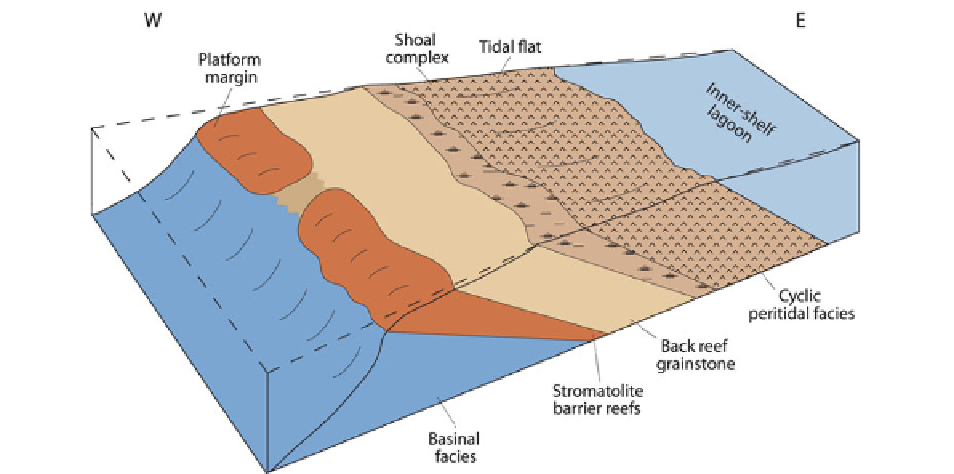Geology Reference
In-Depth Information
Fig. 21.23
Platform paleogeography during the deposition of
the Rocknest Formation (Modifi ed from Grotzinger
1986a
) .
Cyclic peritidal deposits were formed in an extensive back
barrier ('
shoal complex
') tidal fl at facies setting adjacent to a shal-
low subtidal lagoon to the east of the platform
These deposits commonly are characterized by the
paucity of grainstone facies and the dominance of
stromatolite reefs and fi ne-grained carbonate facies
(Grotzinger
1989
). During the Precambrian, stromato-
lites were able to fl ourish in any setting from deep
marine to supratidal and normal to hypersaline waters
(e.g. Hoffman
1976
; Grotzinger
1989
) . Although
skeletal metazoans were absent prior to Cambrian
time, the Precambrian carbonates were deposited in
platforms and environments surprisingly similar to
those of their Phanerozoic counterparts (e.g. Hardie
and Shinn 198, Grotzinger
1989
; Flügel
2010
) .
In the Phanerozoic deposits, in addition to micro-
bialites, micritic carbonates, ooids, oncoids and intrac-
lasts that appeared in the Precambrian platform deposits,
various new components, including skeletal grains and
fecal pellets emerged. A number of metazoans and cal-
careous algae constructed patch, fringing and barrier
reefs and by late Phanerozoic time seagrass probably
contributed in stabilizing mud size sediments in the
subtidal setting. During the Phanerozoic, burrowing
activity by metazoans and increased supply of sand-
to silt-sized bioclasts and peloids restricted microbialites
mainly to areas of low sediment infl ux (Pratt
1982
)
and to more ecologically stressed environments. The
following section of this chapter summarizes facies,
paleo-environment, and cycle/sequence stratigraphic
analyses of a few specifi c examples of ancient carbo-
nate tidal deposits representing the Proterozoic through
Tertiary successions. The examples represent arid and
humid carbonate and mixed carbonate-siliciclastic
tidal deposits that occur in various systems tracts of
depositional sequences related to passive and active
continental margins.
21.7.1 Tidalites of the Rocknest Formation
of Northwest Canada
The Lower Proterozoic (older than 1,800 Ma) Rocknest
Formation is a carbonate platform succession up to
1,200 m thick that was deposited in a westward-facing
passive margin in Northwest Territories, Canada
( Grotzinger
1989
). This summary describes a back
barrier mixed carbonate-siliciclastic peritidal succes-
sion (Hoffman
1975
; Grotzinger
1985,
1986a,
b
) . In
the Rocknest platform, an extensive belt of tidal fl at
environment developed behind a barrier ('shoal-com-
plex') that separated a wave-dominated windward
platform margin to the west from an extensive low
energy inner-shelf lagoon to the east (Fig.
21.23
). The
proximal area of the 'shoal-complex' was seldom

